Introduce step by step how to raise mimosa and what is the function of mimosa.
Mimosa leaves will respond to heat and light, will be touched by external forces will immediately close, so the name mimosa. The flower of mimosa is pink, shaped like a furry ball, and is very likable. Mimosa not only has a better ornamental effect, but also easier to survive, suitable to do balcony, indoor potted flowers. So how to raise mimosa?
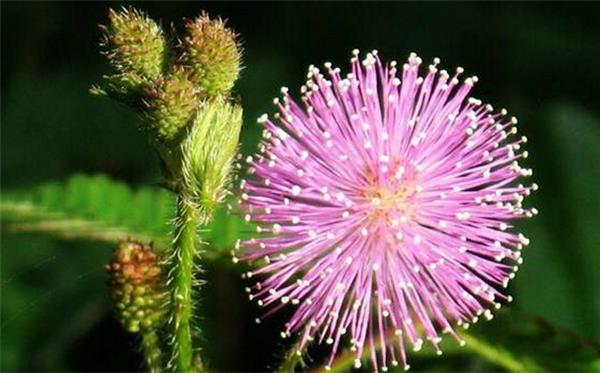
1. Soil. General soil can be cultivated, but the fertile, loose sandy loam is better, which requires the soil to be deep, fertile and moist.
2. Fertilization. Do not need much fertilizer during the growing period, apply dilute liquid fertilizer for 2 or 3 times, fertilizer should not be too much, grow healthily with leaf green, do not grow in vain, because mimosa is mainly interesting foliage flowers, small is better.
3. Watering. Mimosa likes to be moist and needs to be watered frequently, once a day during the summer growing season. Shy prairie is a tropical plant, like a humid environment, so always keep the basin soil moist, watering the basin soil in summer, about once a day, do not let the soil dry, you can often spray water to the plants, and reduce the amount of water in winter to prevent freezing damage.
4. Light. Ensure plenty of sunshine, mimosa likes sunlight, it is best to put it on a sunny balcony or window, full exposure to sunlight is good for mimosa growth, if too little sunlight, it may hinder its growth.
5. to prevent diseases and insect pests, mimosa generally has few diseases and insect pests, and the most common pest is slug. If found, you can sprinkle some lime powder to control it. If the plant does not grow well, check to see if the light source is insufficient or the water is not enough.
You have the same experience, reach out and touch the mimosa leaf, it will immediately close, until your fingers leave, sometimes it is very interesting, touch it a few more times. So mimosa is often described as a "shy ghost", like a shy little girl. Why is the mimosa shy? In fact, this is not called shyness, but a natural physiological response of plants to stimulation and vibration, which is determined by the characteristics of mimosa. So, what are the characteristics of mimosa?
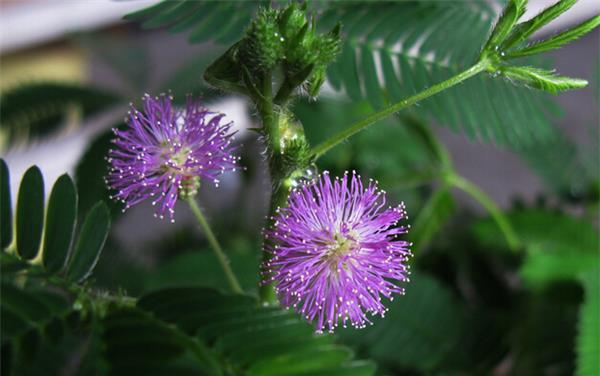
The most obvious feature of mimosa is that when it is stimulated (such as touching), the leaves of mimosa contract immediately and come together. If the stimulation is strong, it will soon be transmitted to the adjacent leaflet or even the leaflet of the real compound leaf, making the petiole droop. Mimosa also responds quickly to stimuli, which usually begins to respond after 0.1 seconds and is completed in a few seconds.
The second characteristic of mimosa is that mimosa closes its leaflets at night, its petiole droops, and in the daytime, when some of its leaflets are shaken, it closes in pairs.
The third characteristic of mimosa is that it is classified as grass in many places because of its strong vitality and messy growth. in fact, it will blossom, just take a look at the picture of mimosa below. Its flowers are pink and its head is spherical in shape like a fluffy ball. Pods will be grafted after flowering, and the fruit is flat and round.
Mimosa, native to tropical America, is a perennial herb of the genus mimosa of Leguminosae. Because of its unique physiological habits, it has many aliases, such as "shy grass, knowledge mimosa, laughing grass, husband and wife grass" and so on. So, is mimosa poisonous?
poisonous.
Shy prairie is produced in tropical South America, like warm and humid, loose requirements on the soil, like light, but can withstand semi-shade, so it can be used for indoor potted flowers. The mimosa leaflet is small, pinnately arranged, and touches the leaflet with the hand. After the lobule is stimulated, it will close. If the shock is strong, the stimulus can be transmitted to the whole leaf, then the total petiole will droop, and even it can be passed to the adjacent leaves to make its petiole droop, as if a girl is shy and drooping powder. But the shy and lovely mimosa is actually poisonous, so we must not underestimate it.
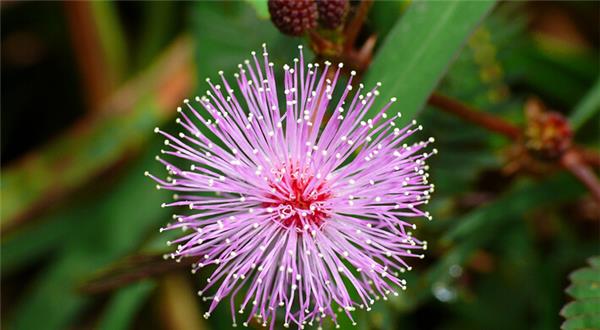
Mimosa contains a substance called mimosa, which is harmful to the human body. if you come into contact with mimosa frequently, it will lead to numb eyebrows, yellow hair and even hair loss. Mimosa is generally not toxic to the human body during the day, but at night, because it cannot carry out photosynthesis, it will release toxic substances. In other words, mimosa is actually poisonous.
Mimosa has a small poison in the whole plant, but it does not have much effect on people. The whole plant of mimosa has a small poison, but it does not have much effect on human beings. The whole plant of mimosa is used in medicine to calm the mind, stop bleeding and relieve pain.
So mimosa had better not be taken. Do not have long-term contact with it, short-term contact, as long as you do not eat poison is not big.
Among plants, there are no eternal advantages and disadvantages, only eternal adaptation. Mimosa has the value of ornamental, medicinal and other convenience, so what are the functions of mimosa?
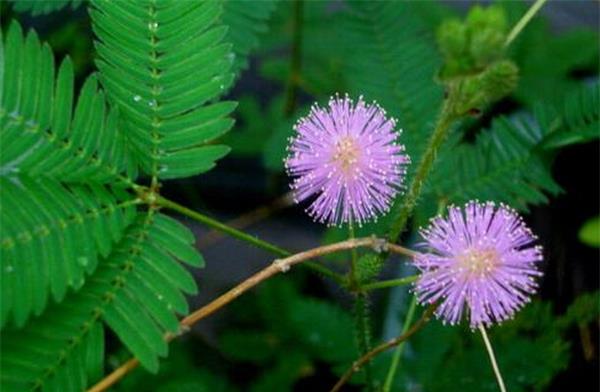
1. Mimosa can predict the weather.
Mimosa is a wonderful plant that can predict changes in the weather. If you touch it with your hand, its leaves close quickly and open slowly, indicating that the weather will clear up; if you touch mimosa, its leaves contract slowly, droop slowly, or even reopen a little bit, this means that the weather will change from sunny to overcast or it is going to rain.
2. It can also predict earthquakes.
Mimosa can predict earthquakes. According to Turkish seismologist Erjiang, a few hours before a strong earthquake, the leaves of mimosa, which are sensitive to the outside world, suddenly shrink and then wither. In earthquake-prone Japan, scientists have found that under normal circumstances, mimosa leaves open during the day and close at night. If the leaves of mimosa close during the day and open at night, it is a sign of an earthquake. For example, at 7: 00 a.m. on January 11, 1938, the mimosa began to open, but at 10:00, all the leaves suddenly closed, and sure enough, a strong earthquake occurred on the 13th. Members of the earthquake Club of Japan in 1976 observed the abnormal closure of mimosa leaves many times, resulting in an earthquake.
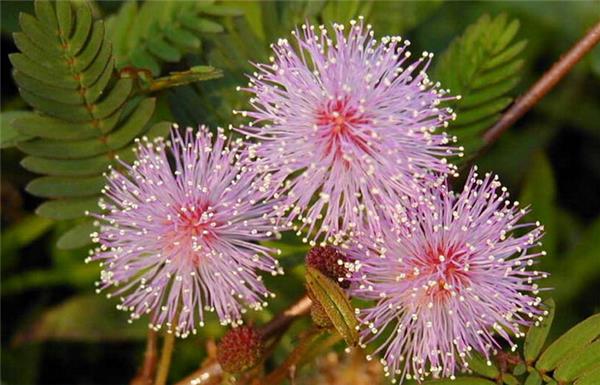
The above is the editor's introduction to mimosa culture, if you still need, you can search the Internet for other relevant information, so that you can better cultivate mimosa. Here, the editor wishes you all a happy breeding and happy life.
1. Mimosa can predict the weather.
Mimosa is a wonderful plant that can predict changes in the weather. If you touch it with your hand, its leaves close quickly and open slowly, indicating that the weather will clear up; if you touch mimosa, its leaves contract slowly, droop slowly, or even reopen a little bit, this means that the weather will change from sunny to overcast or it is going to rain.
2. It can also predict earthquakes.
Mimosa can predict earthquakes. According to Turkish seismologist Erjiang, a few hours before a strong earthquake, the leaves of mimosa, which are sensitive to the outside world, suddenly shrink and then wither. In earthquake-prone Japan, scientists have found that under normal circumstances, mimosa leaves open during the day and close at night. If the leaves of mimosa close during the day and open at night, it is a sign of an earthquake. For example, at 7: 00 a.m. on January 11, 1938, the mimosa began to open, but at 10:00, all the leaves suddenly closed, and sure enough, a strong earthquake occurred on the 13th. Members of the earthquake Club of Japan in 1976 observed the abnormal closure of mimosa leaves many times, resulting in an earthquake.

The above is the editor's introduction to mimosa culture, if you still need, you can search the Internet for other relevant information, so that you can better cultivate mimosa. Here, the editor wishes you all a happy breeding and happy life.
Related
- Wuhan Hospital Iron Tree Blooming Result Was Instantly Frightened by the Gardener Master
- Which variety of camellia is the most fragrant and best? Which one do you like best?
- What is the small blue coat, the breeding methods and matters needing attention of the succulent plant
- Dormancy time and maintenance management of succulent plants during dormancy
- Minas succulent how to raise, Minas succulent plant pictures
- What are the varieties of winter succulent plants
- How to raise succulent plants in twelve rolls? let's take a look at some experience of breeding twelve rolls.
- Attention should be paid to water control for succulent plants during dormant period (winter and summer)
- Watering experience of twelve rolls of succulent plants
- Techniques for fertilizing succulent plants. An article will let you know how to fertilize succulent plants.



